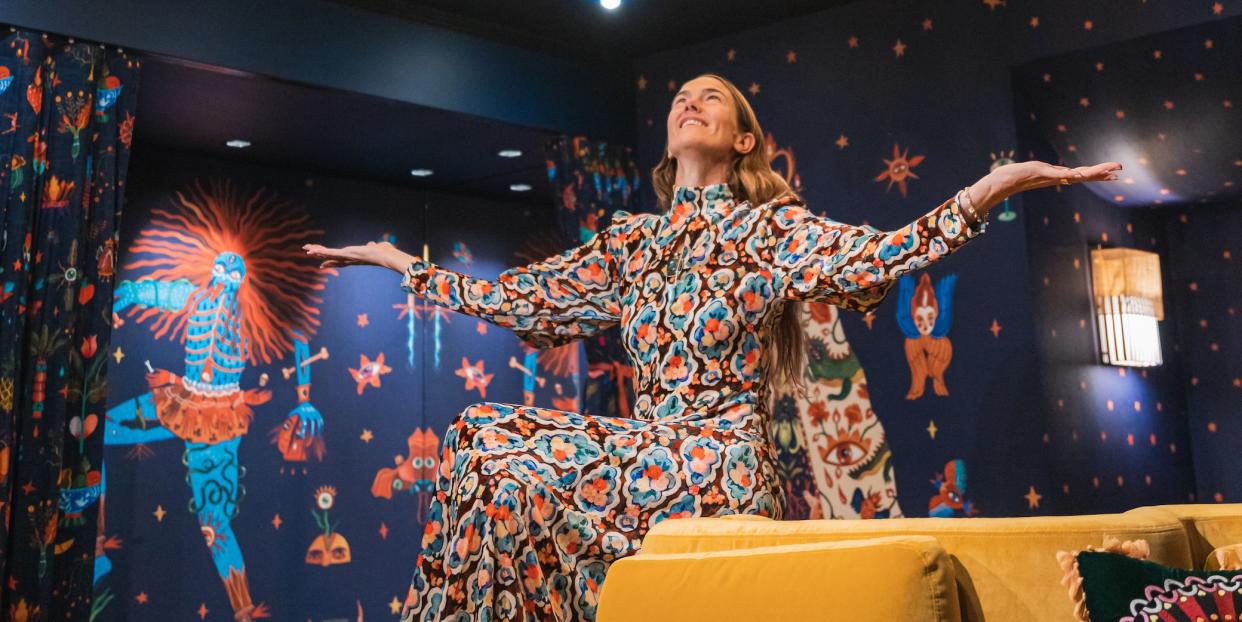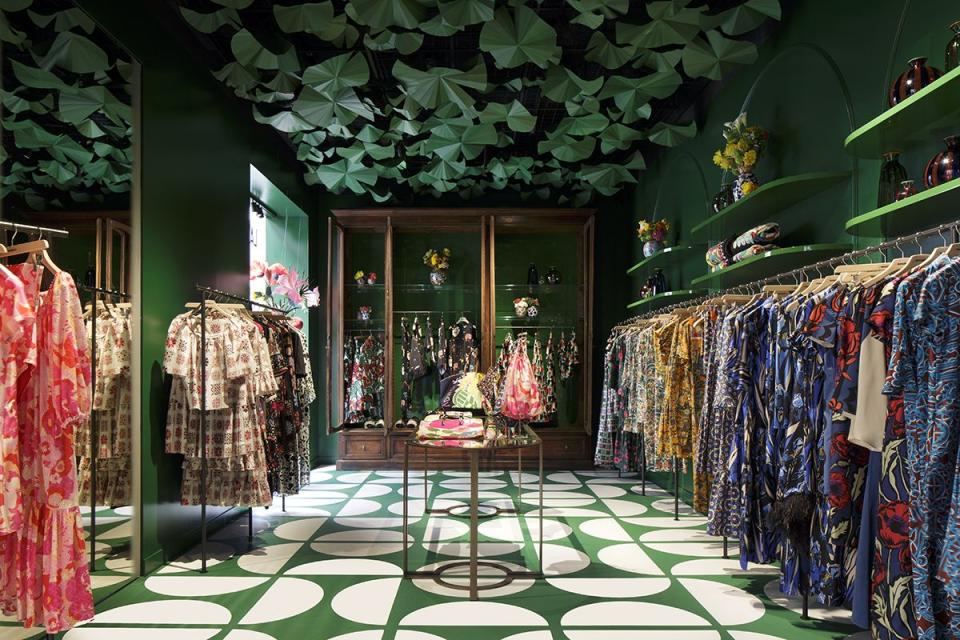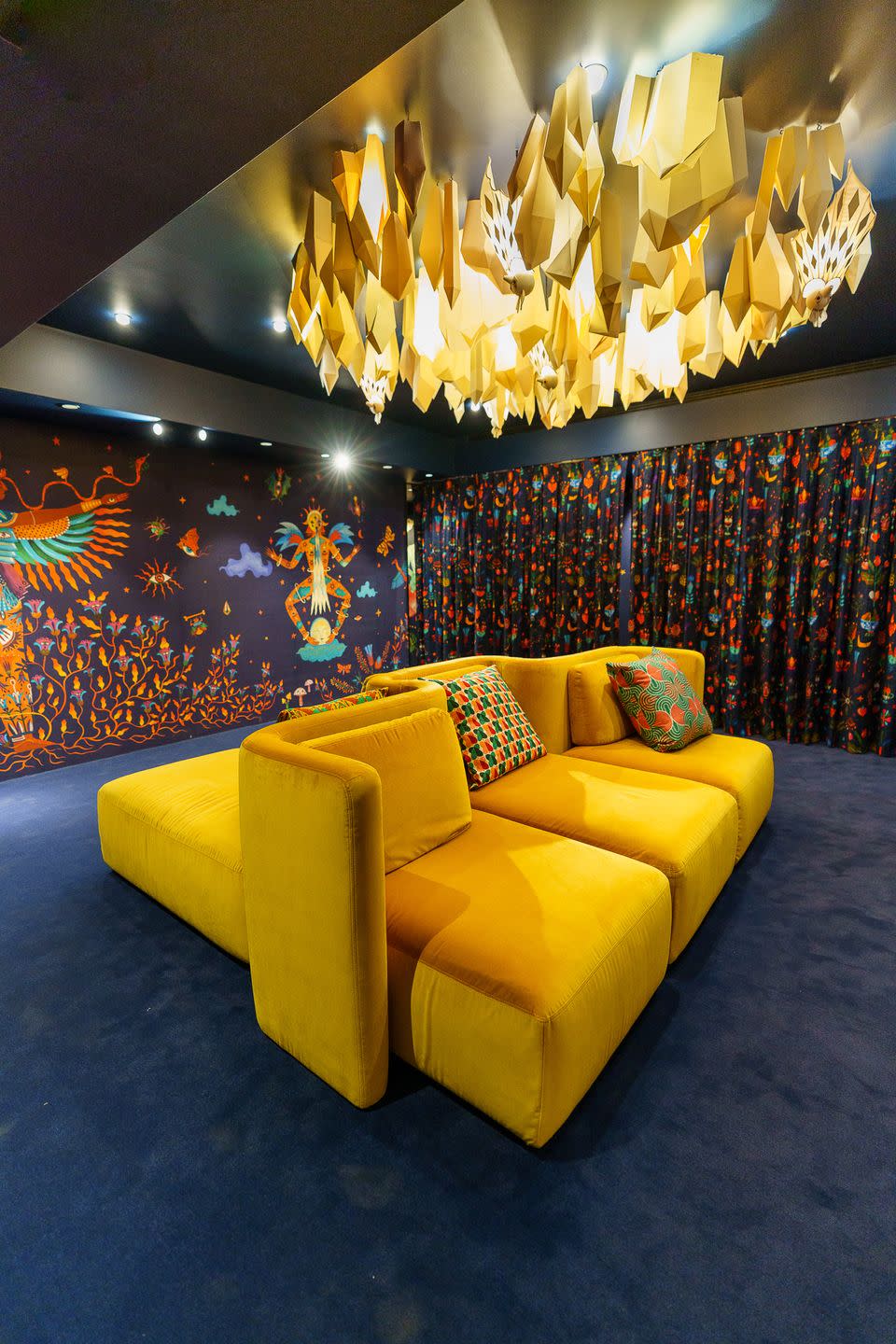At La DoubleJ, a Vibe Unlike Any Other

J.J. Martin’s Milan flagship for her brand, La DoubleJ, is a cheery ground-floor space in the city’s luxury district. Green paper lily pads are strung across the ceiling, echoing a floor tiled in a 1960s-ish pattern of circles, and her charming printed clothes, designed to joyfully clash, sit on the racks like something ready to spring into action. “Wear me!” they seem to cry. In an adjacent room, her porcelain, tablecloths, and cushions suggest any customer can host a dinner party where naughty jokes and witticisms are flung across a riotously attired table.
Milan is a brisk, beige city, more similar in many ways to its Swiss neighbors than its fellow Italian cities like Rome or Naples. Martin’s clothes are happily adjacent to both of those aesthetics. Many of her geometric prints, in deep jewel tones, are jet-set fabulous, fit for a hostess who carries a cigarette holder and owns a palazzo or two. When they are all mixed together, as Martin encourages, they convey a pleasurable maximalism that even a conservative dresser could appreciate. “Everything kind of talks,” she says. “They’re chatty!”
“People come to us for bold, colorful, joyful prints,” she tells me, walking me around her store on a cloudy mid-January afternoon. “Our company motto is ‘Raise your vibration.’ It’s all about having a good time. This is not very serious. Fashion is not very serious. I work hard at this, but at the end of the day, these are clothes that just make you feel good and then make other people respond. This is the kind of clothing that while you’re walking down the street, people are gonna notice, they’re gonna smile, they’re gonna make a comment.”

Martin, who is warm and has the rangy good looks of a 1940s movie star, started her brand in 2015, launching it as an e-commerce platform specializing in vintage clothes photographed on chic but under-the-radar Milan personalities. (In her former life, she was a fashion journalist, working for a time at Harper’s Bazaar; she moved from the United States to Milan with her then-husband and has been based in the city since. Her ex-husband cofounded the brand with her, and the relationship is amicable.) Keeping a steady supply of vintage proved challenging, and she soon introduced a T-shirt dress, the Swing, made of silk twill from an Italian mill and priced at $760 (which she still makes today). By 2017, she was creating small ready-to-wear collections of boho prints cut into super wearable silhouettes, as well as home goods, all produced in Italy, with many, like Murano glass, by storied manufacturers. Her business turned a profit by its second year; Matches, Net-a-Porter, and Moda Operandi all picked it up. On Thursday of this week, she announced that former Chanel CEO Maureen Chiquet would join La DoubleJ as CEO. That same day, she released her Fall 2023 collection at Milan Fashion Week in a deconsecrated church.
“Her clothes are just fun to wear!” a friend recently told me while we were discussing their appeal. “It’s not that complicated!”
La DoubleJ seems poised for a new level of success. She has built her business on ready-to-wear—she has not even made a hit bag or shoe yet—and with a dedicated following that appreciates her high-quality garments that sit easily with much more expensive brands, she could easily to grow her business into something like a Milan-based Tory Burch.
Part of La DoubleJ’s success is that Martin’s brand is not merely products but a lifestyle. Or maybe something beyond a lifestyle. “I was doing a lot of spiritual stuff during the pandemic,” Martin says as she guides me. “One of the things that I was working on a lot was the energy of the divine mother.” We head to a set of gently winding stairs that leads to a space beneath. “This is a transition,” she says of this area. “The subconscious leading down into the divine mother cave.”
“When we talk about different energies,” Martin continues, walking me slowly down the stairs, under a ceiling painted with murals of dragons and other creatures by Heliana Aitch, an artist she discovered on Instagram, “the masculine is all about logic and structure and analyzing and, you know, doing and going. Whereas the feminine is that really slow, soft-feeling, intuitive, mysterious place where the magic unfolds and where all of your spiritual superpowers come out.”

We reach the bottom of the stairs and find ourselves in a deep-blue room that has painted orange and blue murals and a big saffron velvet sofa. “We’ve got the divine mother goddess cave that just also happens to be a bat cave.” She’s not being facetious: A number of adorable paper bats hang from the ceiling. She calls it the Sacred Grotta. We sit down on the sofa, and her pug snorts softly beside us as Martin walks me through the murals of the divine mothers: Isis, Guanyin, Mother Mary, Kali, Green Tara, and a host of archangels. Part of the room houses the swanky dressing rooms, but Martin also uses it for other kinds of client interactions: “We just had a channeler last Monday, Claudia Navone. She was channeling the ascended masters and doing this whole thing about mind-clearing and heart-opening. We’ve had someone do a divine DNA activation. We’ve had theta healing, we’ve had yoga, we’ve done yin practices, we’ve done meditations.”
If this sounds like a world removed from designing a great dress or a snappy set of porcelain, think again. “I’d always kept what I was doing at DoubleJ one thing,” Martin says. “I always had this idea of ‘raise your vibration,’ and the joy and the love for Italy, and let’s have fun. And the prints are all joyful. But at the same time, ‘raise your vibration,’ what that really means is, it honestly puts you in a different energetic frequency to wear those prints and colors.” Still, she was doing spiritual work outside of her business “that was sort of unconventional and not necessarily what a lot of my regular friends were doing.” One of her staffers recommended during the pandemic that she start doing Instagram live talks to chat about these practices and any tips she might have for followers who might be struggling with the crisis. “And I found that our audience for DoubleJ was just as interested in that consciousness conversation as they were in the clothing.”
Now, that piece has become an essential part of the DoubleJ universe. When I visited a DoubleJ pop-up in December at Caffé Roma in Little Italy, in downtown Manhattan, there weren’t just funky plates and delicious lattes on offer. There were also informational postcards, like one titled “LA DOUBLE J SISTERHOOD.” “What does it mean to be a sister?” it asked in rainbow type. “We are the confidantes and creators, the givers and galvanizers. The anchors in your riptide, the fuel in your rocket ship…. Connectors, collaborators, and heart-expanders, we accept you as you are, holding space for you—and all of us—to grow.” Another card detailed the “superpowers of the divine masculine & divine feminine.” (“Divine masculine” listed words like active, logical, and strategic versus feeling, intuitive, and creative for “divine feminine.”)
Martin is even organizing spiritual retreats. In October, she put together an 11-day trip to Egypt with an Egyptian priestess and a shaman. A dozen women signed up. “We were laughing on the trip. So many people got on this magical adventure because of a dress!” says Gail Boulton, a North Carolina–based entrepreneur who signed up by direct messaging Martin after she posted about the trip on Instagram. Boulton, who until recently ran an acrylic-furniture business, says she’s been on a number of similar trips, “and I will say, hands down, it was the most amazing adventure I’ve ever been on.” She praises Martin’s ability to “present spirituality” in a way that is “about connecting inside in a quiet, sacred space.”
The attendees took a boat down the Nile, which Boulton described as womblike: “You got on board and just surrendered.” They would wake up at unusual hours—1 a.m., or 3 a.m., or 4 a.m.—or sometimes they’d gather at 9 p.m. “We went into temples, sitting on the ground in these gorgeous temples that only the pharaohs were in,” Boulton says. “Like, it was never a public space. And it just has the most sacred feel of honoring the ancients and honoring that ancient wisdom. And we are there at four in the morning, and they did these amazing ceremonies, and you’re there for hours alone.”
I tell Boulton that I visited Martin’s store in Milan, which has a similar sacred feeling.
“I can’t even believe you went to Mecca,” she says. “That’s so great. It must have been amazing.”
“Sorry,” I correct her. “I said Milan—not Mecca.”
“Yes,” she says, indicating she’d heard me correctly. “Into J.J.’s store.”
Martin says that her fashion business allows her to speak about things that might otherwise sound too out-there. “I really enjoy using this as a bridge for humans to understand something more,” she says. “I truly enjoy explaining to people what spiritual possibilities they have and helping them understand what blocks they may have.” She says that a woman approached her at a conference hosted by a spiritual teacher in Arizona, and she told Martin that her husband was shocked she wanted to attend something so “woo-woo, until I showed him your Instagram account,” Martin recalls.
“I’m in a unique position because people are watching me and we have a platform here,” she continues. “We have a stage and they think I’m normal”—she laughs—“because I sell dresses. So that allows me to talk about Isis and it not be a fundamentalist group from the Middle East but a huge spiritual presence in my life. It’s like, I can talk about a multidimensional spiritual practice and people are like, ‘But she sells dresses and she looks, like, pretty normal!’”
What’s interesting about Martin’s spiritual endeavors is how closely they seem to relate to her clothes. As uncomplicated as the silhouettes are, the clothes do seem to possess this vibration-raising quality. (The Fall collection is inspired by the Egyptian trip, in fact, with reworked hieroglyphs and palm trees across dresses, trousers, and little jackets, though the references certainly aren’t cartoonish or literal.) It’s not merely Martin’s clothes, of course—“dopamine dressing” is an entire movement, after all—but they unabashedly embrace that potential for positivity and affirmation as their reason for being.
“All of these prints that I work on, I truly believe they’re vibrating. They have energetic codes on them. And once you put them on, you start to kind of feel that power. But there’s a lot of distortion in fashion. So I think that what happens is that people have an inkling that that [feeling is] possible from fashion,” she says, “but people want to consume that and almost, like, have it as a pill or a glass of wine. It becomes an addiction or an attachment of wanting something outside of themselves instead of, like, working on inner beauty or working on inner love or working on inner forgiveness. The clothing should be the reflection of what’s going on on the inside. And oftentimes what’s happening is that there’s nothing happening on the inside! So people are just trying to put it on in order to get that lift.”
It sounds like a remarkably evolved way to think about clothes. Maybe they are inherently spiritual! Maybe the idea of a fashion platform as a kind of spiritual gathering platform makes perfect sense. “I do think that the company itself has its own life force,” Martin says. “She’s an energy baby and she wants to kick and, you know, do air kicks and twirls. And sometimes I just envision her, like, spinning around the globe and just putting color everywhere. And stardust. And I kind of love that. Like, just let her do it!” And with that, she and her pug get up and head back to the design team.
You Might Also Like

